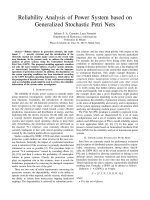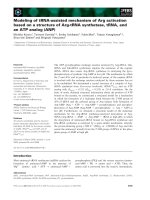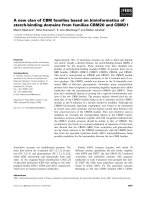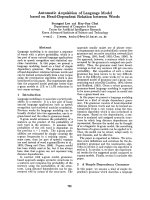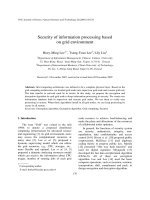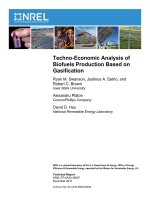PREPARATION OF NANOHYDROGEL STRUCTURE BASED ON PLA PCL PEG PCL PLA PENTABLOCK COPOLYMER FOR CURCUMIN DELIVERY
Bạn đang xem bản rút gọn của tài liệu. Xem và tải ngay bản đầy đủ của tài liệu tại đây (432.24 KB, 1 trang )
PREPARATION OF NANOHYDROGEL STRUCTURE BASED ON PLA-PCLPEG-PCL-PLA PENTABLOCK COPOLYMER FOR CURCUMIN DELIVERY
Nguyễn Văn Cường1,*, Trần Thị Quỳnh Mai1, Nguyễn Văn Bời1, Huỳnh Đại Phú2
1Department of Chemical Engineering, Industrial University of HCMC
2Department of Material Engineering, Ho Chi Minh University of Technology
In this article, thermo-sensitive
hydrogel based on poly(lactide acid)poly(ɛ-caprolactone)-poly(ethylene
glycol)-poly(ɛ-caprolactone)-poly(lactide
acid)
(PLA-PCL-PEG-PCL-PLA)
was
successfully
synthesized
by
using
inverting test-tube method.
The composition and surface
morphology
of
hydrogel
were
characterized by FT-IR and SEM. The
SEM image indicated the hydrogel was
composed of copolymeric network and
nano-sized particles. The curcumin was
entrapped into copolymeric hydrogel. In
vitro drug release behavior was studied in
PBS buffer.
The result showed that controlled
curcumin release was observed. The
release
capacity
decreased
with
increasing curcumin entrapped into
hydrogel, and it decreased with increasing
of copolymer content.
Introduction
Figure 2. FTIR of pentablock popolymer (a),
catechin (b) and catechin-loaded hydrogel (c).
Figure 3. SEM of hydrogel with different
magnifications
Primary Results and
Discussion
30% - 1mg
100
References
0
Figure 1. Copolymeric solution at low
temperature (a) and gel form at 37 oC (b)
20% - 1.5mg
0
a. Synthesis hydrogel pentablock
copolymer
PLA-PCL-PEG-PCL-PLA hydrogel
based on central PCL and PLA blocks
and
end
PEG
blocks
showed
temperature-dependent sol-gel transition
(Figure 1)
The identities of hydrogel and
curcumin-loaded hydrogel were evaluated
by FTIR (Figure 2).
Interior morphology of hydrogel was
investigated by SEM. Hydrogel was
frozen in liquid nitrogen and lyophilized for
12 h before the test (Figure 3).
b. In vitro drug release behavior
In vitro release behavior of curcumin
from PLA-PCL-PEG-PCL-PLA hydrogel
was investigated, which is presented in
Figure 4.
20% - 1mg
20
Email:
The hydrogel was synthesized by using
an inverting test-tube method through a
10 ml tightly screw-capped vial with
inner diameter of 12 mm. The copolymer
solutions were prepared by dissolution
various amount of copolymer in distilled
water. The solutions were transferred
into test tube and slowly heated to 80°C,
then the samples was slowly cool down.
The sol-gel transition was observed
visually by inverting the vials and
condition of gel was defined in 1 min [4].
For curcumin-loaded hydrogel, the 20%
(w/w) copolymeric solution contained
curcumin was prepared and formed
hydrogel as described above.
40
Department of Chemical Engineering
Methods:
60
Dr. Nguyen Van Cuong
Pentablock copolymer PLA-PCL-PEGPCL-PLA was synthesized by ring
opening
copolymerization
of
εcaprolactone and lactide acid with
macroinitiator as poly(ethylene glycol).
Curcumin was purchased from Vietnam
Institute Dietary Supplement (Hanoi,
Vietnam). All chemicals used in this
study were of reagent grade.
80
Contact
Materials:
120 100
Medicines derived from plants play an
important role in the healthcare of many
cultures, both ancient and modern.
Curcumin
(diferuloylmethane,
a
polyphenol) is an active principle of the
perennial herb Curcuma longa (commonly
known as turmeric). Curcumin, a naturally
occurring
polyphenolicphytoconstituent
which presents anticancer, antioxidant,
anti-inflammatory,
hyperlipidemic,
antibacterial,
wound
healing
and
hepatoprotective
activities.
The
therapeutic efficacy of curcumin is limited
due to its poor aqueous solubility and
extensive first pass metabolism.
Hydrogels are water-swollen polymeric
networks and crosslinked polymeric
structures produced by the simple reaction
of one or more monomers, or by
association bonds such as hydrogen
bonds and strong Van der Waals
interactions between chains.
Hydrogels are extremely useful as
biomaterials and can be synthesized to be
responsive for external stimuli. For the last
decades,
scientists
concentrate
to
prepared hydrogel based on diblock and
triblock copolymers such as: PEG-PCL,
PCL-PEG-PCL, PLA-PEG-PLA and so on.
They realized that high molecular weight
PCL need about one year to complete in
vitro biodegradation. Therefore, the
combination of fast degradation PLA with
PCL was to improve the biodegradation
and controlled drug release.
Methods and Materials
Drug release(%)
Abstract
Time (min)
Figure 4. In vitro drug release behavior from
hydrogel
Future work
In this contribution, we synthesized
hydrogel based on PLA-PCL-PEG-PCLPLA copolymer by using test-tube inverting
method. The structures of hydrogel and
curcumin-loaded hydrogel were confirmed
by FT-IR. The porous and 3D structures
were observed by SEM. Additionally, some
nanosized micelles were also seen in SEM.
The in vitro drug release behavior show
that, hydrogel releases drug by swelling,
diffusing and degradation than dissolving.
The hydrogel exhibited the controlled drug
release. Importantly, this study has
demonstrated that the hydrogel can
provide delivery of curcumin for biomedical
applications.
1. Junmin Zhu and Roger E Marchant. Design Properties Of Hydrogel Tissue-Engineering Scaffolds. Expert Rev Med Devices 8(5): 607-626 (2011).
2. T. Kissel, Y. Li, F. Unger, ABA-triblock copolymers from biodegradable polyester A-blocks and hydrophilic poly(ethylene oxide) B-blocks as a candidate for in situ forming hydrogel delivery systems for proteins, Adv. Drug Deliv. Rev.,
54, 99-134 (2002).
3. D. P. Huynh, M. K. Nguyen, B. S. Pi, M. S. Kim, S. Y. Chae, K. C. Lee, B. S. Kim, S. W. Kim, D. S. Lee, Functionalized injectable hydrogels for controlled insulin delivery, Biomaterials, 29, 2527-2534 (2008).
4. H.Đ. Phú, Hydrogel y sinh nhạy nhiệt độ trên cơ sở triblockcopolyme PCLA-PEG-PCLA.Tạp chí Hóa Học, 2: 463-468 (2013).
